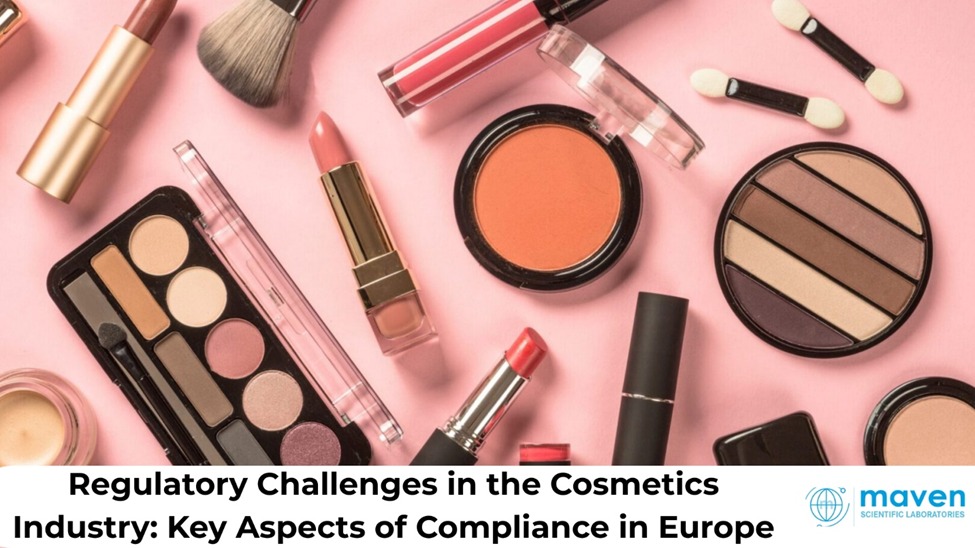Regulatory Challenges in the Cosmetics Industry: Key Aspects of Compliance in Europe
November 14, 2025
The cosmetics industry in Europe is thriving — driven by innovation, sustainability, and consumer demand for safe, ethical, and effective products. However, behind every successful cosmetic brand lies a complex web of regulatory challenges governed by stringent frameworks such as Regulation (EC) No. 1223/2009, REACH, and the oversight of the European Chemicals Agency (ECHA).
At Maven Regulatory Solutions, we understand that compliance is not just a legal obligation — it’s a strategic advantage that builds consumer trust, ensures market access, and safeguards brand reputation in an increasingly globalized industry.
Understanding the Regulatory Landscape
The European Union maintains one of the world’s strictest cosmetic regulatory regimes. Regulation (EC) 1223/2009 forms the cornerstone of compliance, establishing requirements for product safety, labeling, and ingredient transparency.
In addition, the REACH Regulation (Registration, Evaluation, Authorization, and Restriction of Chemicals) ensures that ingredients used in cosmetics are safe for both consumers and the environment. Together, these frameworks uphold the EU’s commitment to high safety standards and sustainable innovation.
Outside Europe, emerging regulations such as the Modernization of Cosmetics Regulation Act (MoCRA) in the U.S. are reshaping global compliance strategies — making it essential for companies to align their global operations.
Key Regulatory Challenges in the European Cosmetics Industry
Compliance within the cosmetics sector is multifaceted and dynamic. Companies must navigate several complex areas, including:
1.Ingredient Safety and Chemical Restrictions
The EU enforces a strict ban on hazardous and carcinogenic substances, including Persistent Organic Pollutants (POPs) and Substances of Very High Concern (SVHCs) under REACH. Manufacturers must maintain full ingredient traceability, ensure risk assessment documentation, and regularly monitor ECHA updates.
2. Animal Testing and Alternative Methods
Under EU law, animal testing for cosmetics and ingredients is prohibited. Companies must use validated alternative testing methods and maintain evidence of ethical safety evaluations.
3.Product Information File (PIF) and Safety Assessment
Every cosmetic product must have a comprehensive Product Information File (PIF) that includes the Cosmetic Product Safety Report (CPSR), product formulation details, and manufacturing compliance under Good Manufacturing Practice (ISO 22716).
4.Responsible Person (RP) Accountability
The Responsible Person acts as the legal compliance authority within the EU, ensuring that products meet all requirements before market placement. The RP oversees labeling, PIF management, Cosmetic Product Notification Portal (CPNP) submissions, and safety communication with authorities.
5.Labeling and Consumer Transparency
Accurate labeling is essential for consumer protection. Each product must display:
- Product name and function
- Full ingredient list (INCI format)
- Responsible Person’s details
- Batch/lot number
- Expiry date (if applicable)
- Warnings or precautions
Failure to comply can lead to enforcement actions, recalls, or market withdrawal.
EU vs. US Cosmetic Regulations: Key Differences
|
Aspect |
European Union (EU) |
United States (US) |
|
Regulatory Authority |
European Commission & ECHA |
FDA |
|
Compliance Model |
Pre-market approval (mandatory PIF & CPNP notification) |
Post-market surveillance |
|
Animal Testing |
Strictly prohibited |
Not explicitly banned |
|
Ingredient Control |
Prohibited & restricted substance lists under EC 1223/2009 |
Fewer pre-market restrictions |
|
Responsible Person Requirement |
Mandatory |
Not required |
|
Documentation |
Safety assessment, labeling, GMP evidence |
Voluntary unless challenged |
These differences mean that global cosmetic brands must adopt dual compliance strategies to meet both EU and U.S. market expectations.
REACH Compliance: Ingredient Transparency and Safety
Ensuring compliance with REACH is critical for market authorization in Europe. Cosmetic manufacturers must:
- Register all chemical substances used above regulatory thresholds
- Identify Substances of Very High Concern (SVHCs)
- Communicate with suppliers to confirm compliance status
- Maintain updated safety data sheets (SDS)
Failure to meet REACH obligations can result in severe penalties and loss of EU market access.
Sustainability and Ethical Sourcing: The New Compliance Frontier
Modern consumers expect transparency, ethical sourcing, and environmental accountability. Cosmetic brands are increasingly integrating sustainability certifications, eco-labels, and biodegradable ingredients into their formulations.
EU initiatives supporting circular economy principles are also influencing packaging regulations — encouraging recyclable materials and reducing waste. Companies that embed sustainability within compliance frameworks gain a competitive edge in the European market.
Future Trends in Cosmetics Regulation
The cosmetics regulatory landscape continues to evolve. Key trends include:
- Digitalization of regulatory processes (e.g., online CPNP systems, AI-driven compliance monitoring)
- Global harmonization through collaboration among EU, ASEAN, and U.S. authorities
- Increased oversight on sustainability claims and greenwashing prevention
- Integration of biotechnology and in-vitro testing methods as part of next-gen safety evaluations
These developments will redefine how brands approach regulatory affairs, requiring agile compliance strategies and real-time monitoring.
How Maven Regulatory Solutions Supports Cosmetic Compliance
At Maven Regulatory Solutions, we provide end-of-end support to help cosmetic companies meet EU and global compliance standards with confidence.
Our services include:
- Preparation and review of Product Information Files (PIFs)
- Designation and management of Responsible Person (RP) services
- REACH and CLP compliance audits
- Labeling and claims validation per EC 1223/2009
- Cosmetic Product Safety Reports (CPSR) preparation
- Regulatory strategy alignment with ECHA and European Commission requirements
With Maven’s expertise, your brand achieves regulatory readiness, consumer trust, and faster market entry — all while maintaining quality and safety excellence.
Conclusion
Navigating the European cosmetics regulatory landscape demands expertise, vigilance, and strategic foresight. By prioritizing compliance with EC 1223/2009, REACH, and ECHA guidelines, cosmetic companies can ensure product safety, ethical integrity, and market sustainability.
Partner with Maven Regulatory Solutions to transform regulatory challenges into opportunities — ensuring your products meet every requirement with precision and confidence.


Post a comment